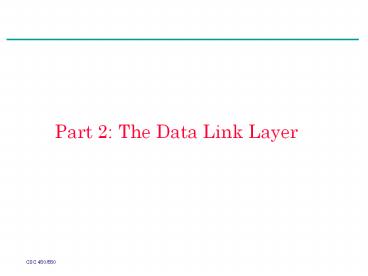Part 2: The Data Link Layer - PowerPoint PPT Presentation
Title: Part 2: The Data Link Layer
1
Part 2 The Data Link Layer
2
Summary
- Part A Functions
- Functions of the data link layer
- Framing
- Error control
- (3.1) Error detection
- (3.2) Error correction
- Flow control
- Part B Protocols
- Definitions
- Elementary data link protocols
- Sliding window protocols
- Example data link protocol - PPP
3
Part A Functions
4
(1) Functions of the Data Link Layer
- Provide service interface to the network layer
- Dealing with transmission errors
- Regulating data flow
- Slow receivers not swamped by fast senders
5
(2.1) Framing
- A character stream. (a) Without errors. (b)
With one error.
6
(2.2) Framing
- (a) A frame delimited by flag bytes.
- (b) Four examples of byte sequences before and
after stuffing.
7
(2.3) Framing
- Bit stuffing
- (a) The original data.
- (b) The data as they appear on the line.
- (c) The data as they are stored in receivers
memory after destuffing.
8
(2.4) Framing
- Physical Layer Coding Violations
- Used only when physical medium contains some
redundancy - 1 high-low
- 0 low-high
- high-high and low-low are used for delimiting
frames
9
(3.1) Error-Detecting Codes
Calculation of the polynomial code checksum.
10
(3.2) Error-Correcting Codes
- Use of a Hamming code to correct burst errors.
11
(4) Flow Control
- Feedback-based flow control
- Rate-based flow control
12
Part B Protocols
- Definitions
- Elementary data link protocols
- Sliding window protocols
- Example data link protocol - PPP
13
(1.1) Protocol Definitions
Continued ?
Some definitions needed in the protocols to
follow. These are located in the file protocol.h.
14
(1.2)Protocol Definitions(ctd.)
Some definitions needed in the protocols to
follow. These are located in the file
protocol.h.
15
(2) Elementary Data Link Protocols
- An Unrestricted Simplex Protocol
- A Simplex Stop-and-Wait Protocol
- A Simplex Protocol for a Noisy Channel
16
(2.1)Unrestricted Simplex Protocol
17
(2.2)Simplex Stop-and-Wait Protocol
18
(2.3.1)A Simplex Protocol for a Noisy Channel
A positive acknowledgement with retransmission
protocol.
Continued ?
19
(2.3.2) A Simplex Protocol for a Noisy Channel
(ctd.)
A positive acknowledgement with retransmission
protocol.
20
(3) Sliding Window Protocols
- A One-Bit Sliding Window Protocol
- A Protocol Using Go Back N
- A Protocol Using Selective Repeat
21
(3) Sliding Window Protocols (2)
- A sliding window of size 1, with a 3-bit sequence
number. - (a) Initially.
- (b) After the first frame has been sent.
- (c) After the first frame has been received.
- (d) After the first acknowledgement has been
received.
22
(3.1.1) A One-Bit Sliding Window Protocol
Continued ?
23
(3.1.2) A One-Bit Sliding Window Protocol (ctd.)
24
(3.1.3) A One-Bit Sliding Window Protocol
- Two scenarios for protocol 4. (a) Normal
case. (b) Abnormal case. The notation is (seq,
ack, packet number). An asterisk indicates where
a network layer accepts a packet.
25
(3.2.1) A Protocol Using Go Back N
- Pipelining and error recovery. Effect on an
error when - (a) Receivers window size is 1.
- (b) Receivers window size is large.
26
(3.2.2) Sliding Window Protocol Using Go Back N
Continued ?
27
(3.2.3) Sliding Window Protocol Using Go Back N
Continued ?
28
(3.2.4) Sliding Window Protocol Using Go Back N
Continued ?
29
(3.2.5) Sliding Window Protocol Using Go Back N
30
(3.2.6) Sliding Window Protocol Using Go Back N
- Simulation of multiple timers in software.
31
(3.3.1) A Sliding Window Protocol Using Selective
Repeat
Continued ?
32
(3.3.2) A Sliding Window Protocol Using Selective
Repeat
Continued ?
33
(3.3.3) A Sliding Window Protocol Using Selective
Repeat
Continued ?
34
(3.3.4) A Sliding Window Protocol Using Selective
Repeat
35
(3.3.5) A Sliding Window Protocol Using Selective
Repeat
- (a) Initial situation with a window size seven.
- (b) After seven frames sent and received, but not
acknowledged. - (c) Initial situation with a window size of four.
- (d) After four frames sent and received, but not
acknowledged.
36
(4) PPP
- Read RFC 1661 http//www.faqs.org/rfcs/rfc1661.ht
ml
37
(4.1) PPP Point to Point Protocol
- The PPP full frame format for unnumbered mode
operation.
38
(4.2) PPP Point to Point Protocol
- A simplified phase diagram for bring a line up
and down.
39
(4.3) PPP Point to Point Protocol
- The LCP frame types.































